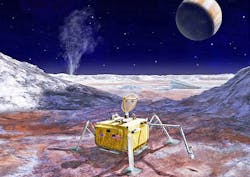NASA JPL asks industry for lidar electro-optical sensor to help unmanned spacecraft land on Europa
PASADENA, Calif. – U.S. government space researchers are surveying industry for light detection and ranging (lidar) electro-optical sensor technology that could enable a future unmanned spacecraft to land safely on the rugged terrain of Europa -- a large moon orbiting Jupiter that may be able to support life.
Officials of the Jet Propulsion Laboratory (JPL) in Pasadena, Calif., issued a solicitation Friday (RFP_MD-2673-949208) for the Technology Development for Europa Lander Lidar project.
JPL, a federally funded research and development center of the U.S. National Aeronautics and Space Administration (NASA), is pre-phase A development for a lander mission to Europa.
The NASA Europa mission is schedule for sometime in the 2020s, and will seek to conduct detailed reconnaissance of this moon of Jupiter, and investigate whether the icy moon could harbor conditions suitable for life.
Safe and accurate landing on the hazardous terrain of Europa presents several unique challenges that require a lidar active ranging sensor system. The Europa lander's lidar will have dual functionality -- altimetry and hazard mapping.
NASA JPL researchers are looking for a lidar system that is robust enough for the extreme Jovian and Europan environments, and that is compatible with the future lander's deorbit, descent and landing. NASA JPL is conducting trade studies for components and architectures, analyses of environmental impacts on the sensor, and evaluation and progressive refinement of various sensor design options leading to an eventual point design.
Technological details of this solicitation are not available to the general public because some of its documents are export controlled. Interested proposers should email JPL Subcontracts Manager Mai Drummond at [email protected] to receive the solicitation documents.
Responses to this Europa lander lidar solicitation are due to NASA JPL no later than 31 Aug. 2017. For more information contact NASA's Mary Helen Ruiz by email at [email protected], or by phone at 818-354-7532.
Also contact NASA JPL's Mai Drummond by email at [email protected], or by phone at 818-354-0295.
More information is online at https://www.fbo.gov/notices/f5abb1442601c70bbe9b408cc4ea81b6.
Learn more: search the Aerospace & Defense Buyer's Guide for companies, new products, press releases, and videos

